I need to define an equation to represent a series of points from a model. As they are predictions from an already fit non-linear regression, noise shouldn't really be an issue. I have seen many examples that allow predictions to be made on the curves, but I am still confused about how I can retrieve an equation from various functions such as spline, etc.
Based on the formula I supplied for the nonlinear regression in brms (b1^b2, where b1 ~ 1 + x and b2 ~ 1), I would expect the relationship to resemble some sort of power function [ax^b or possibly (int + ax)^b].
I understand it may be just an approximation - that is fine as long as it is relatively similar (will be plot alongside model for comparison). Would greatly appreciate any insight whatsoever, let me know if I can provide further information. Have provided example data below.
x <- c(7, 7.5, 8, 8.5, 9, 9.5, 10, 10.5, 11, 11.5,
12, 12.5, 13, 13.5, 14, 14.5, 15, 15.5,
16, 16.5, 17, 17.5, 18, 18.5, 19, 19.5,
20, 20.5, 21, 21.5, 22, 22.5, 23, 23.5,
24, 24.5, 25, 25.5, 26, 26.5, 27, 27.5,
28, 28.5, 29, 29.5, 30, 30.5, 31, 31.5,
32, 32.5, 33, 33.5, 34, 34.5, 35, 35.5,
36, 36.5, 37, 37.5, 38, 38.5, 39, 39.5,
40, 40.5, 41, 41.5, 42, 42.5, 43, 43.5,
44, 44.5, 45, 45.5, 46, 46.5, 47, 47.5,
48, 48.5, 49, 49.5, 50, 50.5, 51, 51.5,
52, 52.5, 53, 53.5, 54, 54.5, 55, 55.5,
56, 56.5, 57, 57.5, 58, 58.5, 59, 59.5,
60, 60.5, 61)
y <- c(38.0136100143096, 41.7377019494229, 45.0570784133659, 49.7413206704322,
54.1226793545035, 58.5143924911556, 64.0149939443995, 70.2996105120598,
74.5157778956172, 82.0845639640055, 88.1447395709772, 96.0901896008888,
104.331306746698, 112.587794035369, 116.793284692497, 129.660032344424,
139.148796580701, 154.021720779283, 164.352212638548, 174.265834929441,
186.345636353806, 199.537020067263, 217.599140020487, 233.877433057235,
246.132735977878, 267.47374365421, 283.863259012889, 301.899794004843,
322.769938301311, 351.430583957233, 383.849198025211, 390.736999633559,
423.249193342341, 454.638021905869, 485.240521462023, 509.31872397953,
560.804077944124, 580.52077607546, 623.750134417424, 663.267081364541,
698.778452300861, 737.091827116676, 796.938400847035, 856.419990917143,
906.017778910945, 965.168165262045, 1013.84413110147, 1065.85753522486,
1154.33958805326, 1204.13058748532, 1322.42312105971, 1385.41472565674,
1464.95636449756, 1526.04430007742, 1609.84006688626, 1738.45992222218,
1816.05261609804, 1896.50702990984, 2024.59349402727, 2142.55345863206,
2216.16848789472, 2384.32905391336, 2534.20713772314, 2599.97048189298,
2800.82684813604, 2956.9306593113, 3133.9558188069, 3320.82577045419,
3477.57994233654, 3602.69160098815, 3800.51701252841, 4062.6001499355,
4238.73826354165, 4645.61124406474, 4731.78190196944, 4947.75977778357,
5211.86923419648, 5619.65143369664, 5817.33879970144, 6079.00167282099,
6205.39929607976, 6681.42573862285, 7198.53801041513, 7267.01092369979,
7816.95660375773, 8133.793609116, 8261.13289172042, 9053.74531584895,
9473.33768555856, 10137.0504777871, 10400.797014819, 10966.3727089692,
11494.3384956937, 11920.4271066324, 12400.9643350626, 13096.7674700334,
13798.7159321491, 14358.3675127649, 15266.2675882016, 16072.0949530508,
17058.7362901159, 17663.6886724086, 18390.5282871649, 19307.9213621373,
20392.6725381775, 21431.4257870743, 21624.312458088, 23099.2069971926,
24090.3844352512)
data <- data.frame(x, y)
library(ggplot2)
ggplot(data, aes(x,y)) + geom_point()
EDIT: reply to @Bernhard
Yes, I tried to use these outputs, but have not found them to approximate the curve very well - perhaps I am misunderstanding how to use them.
So if my brms output looks like this:
Family: lognormal
Links: mu = identity; sigma = identity
Formula: weight.g ~ b1^b2
b1 ~ 1 + dia.1.cm
b2 ~ 1
Data: CaesCombBot.data.wfrag (Number of observations: 2619)
Samples: 4 chains, each with iter = 5000; warmup = 2000; thin = 5;
total post-warmup samples = 2400
Population-Level Effects:
Estimate Est.Error l-95% CI u-95% CI Rhat Bulk_ESS Tail_ESS
b1_Intercept 6.61 0.81 5.08 8.24 1.00 1741 1787
b1_dia.1.cm 0.98 0.42 0.42 2.07 1.00 1738 1974
b2_Intercept 0.57 0.06 0.46 0.70 1.00 1727 1942
Family Specific Parameters:
Estimate Est.Error l-95% CI u-95% CI Rhat Bulk_ESS Tail_ESS
sigma 0.56 0.01 0.54 0.57 1.00 2156 2105
Samples were drawn using sampling(NUTS). For each parameter, Bulk_ESS
and Tail_ESS are effective sample size measures, and Rhat is the potential
scale reduction factor on split chains (at convergence, Rhat = 1).
How can I use this to recreate the equation?
When I try for example
curve((6.61 + 0.98*x)^0.57, from = 0, to = 50)
Just doing a quick comparison: x value of 40 (6.61 + 0.98*40)^0.57 = exp(8.846) [modelled in lognormal dist] = 6946.547
I understand it doesn't look the same (as its also within a log normal distribution), but would expect the exp values to match that of the graph below? (x value of 40 corresponding to 5256.29 according to add_predictions)


